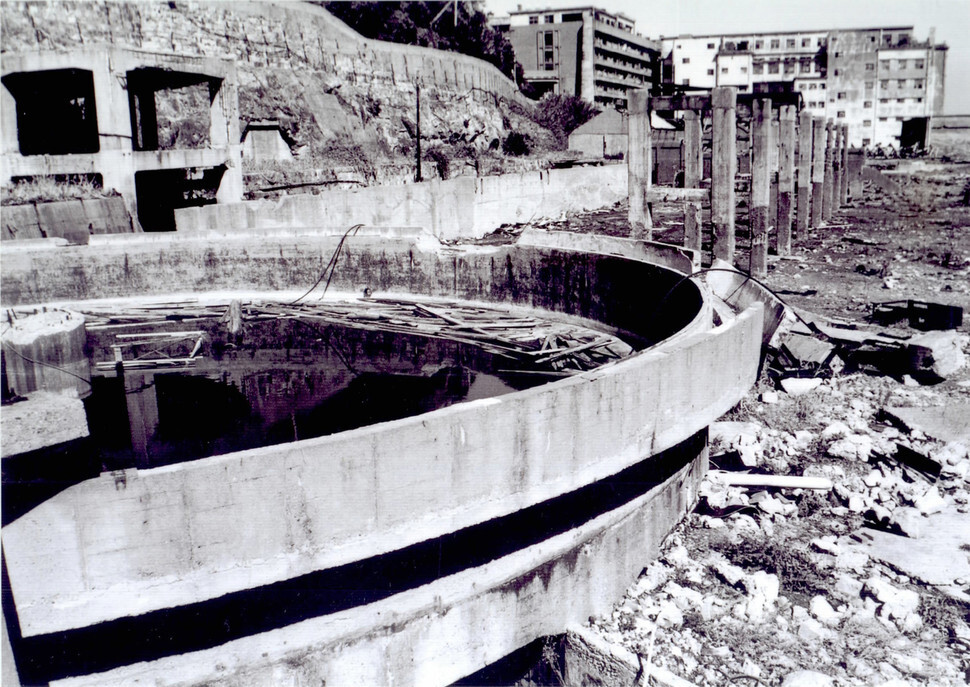hankyoreh
Links to other country sites 다른 나라 사이트 링크
Japan continues to omit Korean forced laborers from UNESCO report on Hashima Island

In the second progress report about follow-up measures for Meiji industrial revolution sites inscribed on UNESCO’s World Heritage List, the Japanese government once again failed to acknowledge Korean labor conscripts who worked at those sites or to outline measures to honor those who died during such labor, the Hankyoreh has discovered. The 23 coal mines and iron and steel works that Japan added to the UNESCO list in 2015 include Hashima Island, also called Battleship Island, in Nagasaki Prefecture, an infamous site where Koreans were mobilized for forced labor.
Japan’s conservation status report about the Meiji industrial sites that was posted to the World Heritage Center’s website on Dec. 23 made no mention of the suffering of Korean forced laborers. When UNESCO was reviewing Japan’s application in 2015, a Japanese government spokesperson acknowledged that “Koreans were mobilized against their will and performed forced labor [at Hashima Island and other industrial sites] in the 1940s” and promised to “take measures to honor those who died there by setting up information centers.”
But the 2017 conservation status report avoided terms such as “forced labor” and announced instead that “exhibitions would aid the understanding that people from the Korean Peninsula made contributions at Japan’s industrial sites.” During a meeting in Bahrain in July 2018, UNESCO reminded Japan once more of its previous recommendation and suggested that it benchmark exemplary cases around the world in providing a total historical interpretation, but now Japan has completely removed any mention of Korean victims of forced labor. Japan also ducked a question about its “interpretive strategy” for communicating the facilities’ meaning and value to people visiting related exhibitions, only saying that it had addressed that subject in its 2017 report.
When the Japanese government announced in its 2017 conservation status report that it would set up an information center in Tokyo, 980km away from Hashima Island, it came under fire for attempting to sidestep the issue of Korean victims of forced labor. This year’s report states that an information center will be built in Wakamatsu, in the Shinjuku Ward of Tokyo, within this fiscal year, without specifying what will be exhibited there.
In response to UNESCO’s call for dialogue between the parties concerned, Japan only said that “regular dialogue is being held between a wide range of parties, including the relevant ministries, local governments, the owners and managers of the sites, experts both inside and outside of Japan, and local communities.” In short, there was no mention of efforts to engage in dialogue with the government of South Korea, a state party connected with the sites. The likely result is that the sites registered with UNESCO will be only promoted as places that highlight Japan’s successful industrialization during the Meiji era, erasing the history of Koreans drafted for forced labor there.
Concerns had already been raised even before the progress report came out. The organization that the Japanese government had commissioned to conduct research about the Meiji industrial sites is the National Congress of Industrial Heritage, which has continued to draft reports that deny or downplay the forced labor performed by Koreans.
S. Korean foreign ministry hints at “direct action” to UNESCOThe South Korean government expressed its regret in a statement issued by the spokesperson of its Ministry of Foreign Affairs. “We cannot hide our disappointment about Japan’s submission of this one-sided report and its refusal to accept our repeated requests for dialogue, even though the World Heritage Committee has recommended dialogue between the parties concerned, which include South Korea,” the statement said.
“We will take direct action to make the World Heritage Center, which handles the implementation report, aware that the Japanese government is not fulfilling its obligations. We will also call on Japan implement [its agreements] in multilateral forums such as the World Heritage Committee,” a Ministry official said.
By Cho Ki-weon, Tokyo correspondent, and Kim So-youn, staff reporter
Please direct comments or questions to [english@hani.co.kr]

Editorial・opinion
![[Editorial] Penalties for airing allegations against Korea’s first lady endanger free press [Editorial] Penalties for airing allegations against Korea’s first lady endanger free press](https://flexible.img.hani.co.kr/flexible/normal/500/300/imgdb/original/2024/0502/1817146398095106.jpg) [Editorial] Penalties for airing allegations against Korea’s first lady endanger free press
[Editorial] Penalties for airing allegations against Korea’s first lady endanger free press![[Editorial] Yoon must halt procurement of SM-3 interceptor missiles [Editorial] Yoon must halt procurement of SM-3 interceptor missiles](https://flexible.img.hani.co.kr/flexible/normal/500/300/imgdb/child/2024/0501/17145495551605_1717145495195344.jpg) [Editorial] Yoon must halt procurement of SM-3 interceptor missiles
[Editorial] Yoon must halt procurement of SM-3 interceptor missiles- [Guest essay] Maybe Korea’s rapid population decline is an opportunity, not a crisis
- [Column] Can Yoon steer diplomacy with Russia, China back on track?
- [Column] Season 2 of special prosecutor probe may be coming to Korea soon
- [Column] Park Geun-hye déjà vu in Yoon Suk-yeol
- [Editorial] New weight of N. Korea’s nuclear threats makes dialogue all the more urgent
- [Guest essay] The real reason Korea’s new right wants to dub Rhee a founding father
- [Column] ‘Choson’: Is it time we start referring to N. Korea in its own terms?
- [Editorial] Japan’s rewriting of history with Korea has gone too far
Most viewed articles
- 1Months and months of overdue wages are pushing migrant workers in Korea into debt
- 2Trump asks why US would defend Korea, hints at hiking Seoul’s defense cost burden
- 31 in 3 S. Korean security experts support nuclear armament, CSIS finds
- 4[Editorial] Yoon must halt procurement of SM-3 interceptor missiles
- 5Fruitless Yoon-Lee summit inflames partisan tensions in Korea
- 6[Guest essay] Maybe Korea’s rapid population decline is an opportunity, not a crisis
- 7[Editorial] Penalties for airing allegations against Korea’s first lady endanger free press
- 8Bills for Itaewon crush inquiry, special counsel probe into Marine’s death pass National Assembly
- 9[Column] Can Yoon steer diplomacy with Russia, China back on track?
- 10At heart of West’s handwringing over Chinese ‘overcapacity,’ a battle to lead key future industries